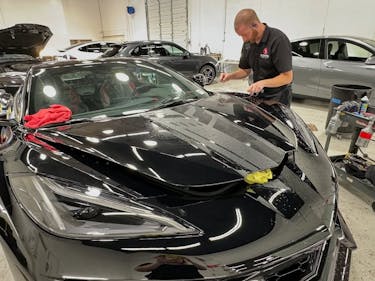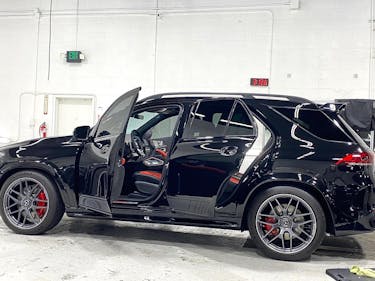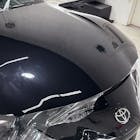Why Where You Get Your PPF Installed Matters More Than You Think
Paint Protection Film (PPF) is one of the smartest investments you can make to preserve your vehicle’s appearance. But not all installations are created equal. Choosing the right installer can be the difference between a flawless, nearly invisible finish — and an expensive, frustrating mess.

The Value of PPF—Only as Good as Its Installation
PPF is a clear, durable film that acts like a shield against rock chips, scratches, bug splatter, bird droppings, and even UV rays. High-quality film from brands like XPEL can self-heal minor scratches and maintain a glossy, "just-detailed" look for years.
But even the best film will fail if it’s installed incorrectly. This is why choosing a certified, experienced installer is just as important (if not more) than the product itself.
What Can Go Wrong with a Bad PPF Install?
Unfortunately, there’s a lot that can go wrong when PPF isn’t installed by a trained professional. Here are some of the most common issues:
1. Lifting and Peeling Edges
Improper surface prep or rushed installation can lead to edges lifting over time, especially around curves or panel gaps. This not only looks bad—it allows dirt and moisture to get underneath the film, leading to further deterioration.
2. Trapped Debris and Bubbles
PPF needs to be applied in a clean, controlled environment. If dust or debris is trapped under the film, you’ll see tiny bumps or air pockets that ruin the look and compromise protection.
3. Visible Seams and Stretch Marks
Inexperienced installers may not align panels correctly or may overstretch the film, leading to distorted finishes, visible seams, or inconsistent texture across surfaces.
4. Cutting Directly on the Paint
Some installers still hand-cut film using razor blades. If not done with extreme precision, this can leave behind fine cuts in your vehicle’s clear coat—permanently damaging the paint the film was meant to protect.
5. Poor Film Coverage
A proper install should provide maximum coverage while remaining nearly invisible. Inadequate installs may leave exposed edges or high-impact areas like the hood or fenders partially unprotected.

What Makes a PPF Installation High Quality?
Not every shop or technician is trained to install PPF properly. Here’s what you should look for to ensure your investment pays off:
1. Certified Installers
Choose a shop with certified technicians from trusted brands like XPEL. Certification means they’ve been formally trained on best practices and precision techniques. Brands will also further-recognize the region’s top dealers with special awards — like the one Benchmark received when it was named Washington’s Top XPEL Dealer of 2024.
2. Fully Wrapped
Even when PPF is cut with a machine, it leaves a small line where the edge of the PPF. To avoid this, the top shops will fully wrap the edges of a vehicle’s exterior so none of the exposed paint is uncovered and the PPF is not visible.
3. Controlled Environment
A dust-free, climate-controlled workspace is essential for a clean install. Avoid shops that install outdoors or in cluttered garages. Any foreign particles that are introduced during the installation process will be trapped under the film, creating marks, swirls, bubbles, and distortions to the paint’s finish.
4. Thorough Surface Prep
Proper preparation is non-negotiable. Your vehicle must be meticulously washed, decontaminated (often with a clay bar or isopropyl alcohol), and free of wax, sealants, or debris before application.
Prior to any PPF application at Benchmark, all vehicles undergo an extensive prep session. This session takes at least six hours of washing and prepping the surface.
5. Post-Install Inspection and Curing
A high-quality install includes post-application heat curing and detailed inspection to remove bubbles and ensure edges are sealed.
6. Warranty and Customer Support
Good shops stand behind their work. Look for warranties that cover defects in both the film and the installation itself. Avoid installers who can't explain their warranty or won’t stand by their craftsmanship.

Why Experience and Reputation Matter
Ultimately, PPF installation is as much art as it is science. Experience matters. A reputable installer will know how to handle complex curves, avoid overstretching, align patterns precisely, and communicate clearly about what’s included.
Before booking an appointment, ask:
How long have they been installing PPF?
Benchmark has been installing PPF since 2001.
What brands do they use?
We use XPEL products for all of our services. Over the years we’ve personally tested the industry’s leading brands on our own vehicles. The products we carry have been carefully curated based on this experience and our experience living (and driving cars) in the greater Seattle area.
Can you see examples of their recent work?
We regularly share new projects on our Facebook page and Instagram profile. We also welcome customers who visit us in-person to look at current projects in our warehouse and recently completed projects in our parking lot.
Do they have online reviews or client testimonials?
In addition to the testimonials you’ll find on our website, we have more than 250 reviews on Google and Facebook combined with a five-star rating on Google.
Do they offer a written warranty?
We offer a clear warranty for each of our services, clearly labeled on each service page.
Don’t Cut Corners on Protection
Your vehicle deserves more than just the cheapest quote. Paint Protection Film is a long-term investment in preserving your car’s beauty and resale value, but only if it’s installed correctly.
By choosing a professional, certified installer with a proven track record, you’re ensuring that your PPF will look great, last longer, and actually protect what matters most: your paint.
Thinking about PPF? Choose quality. Choose experience. Choose peace of mind.


